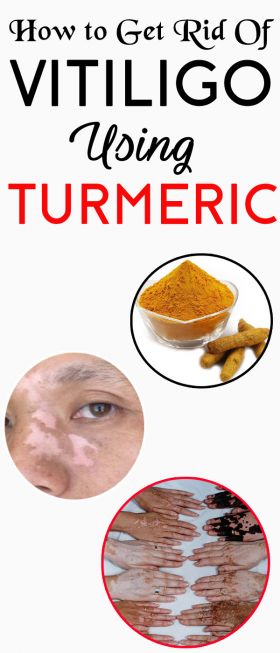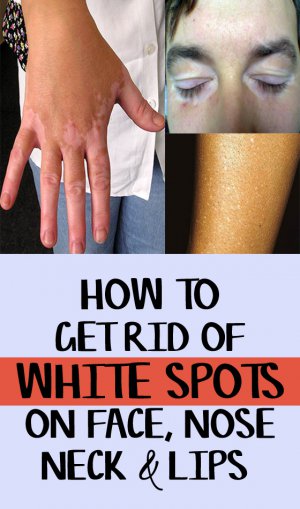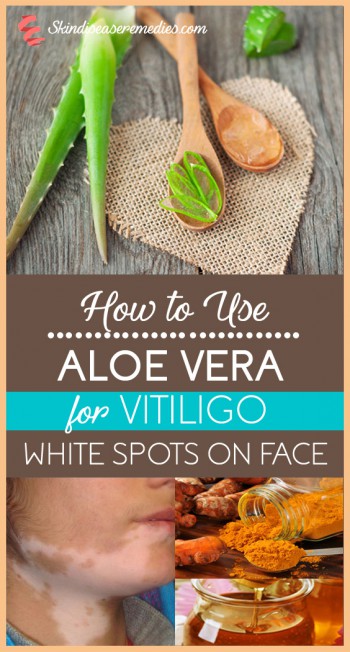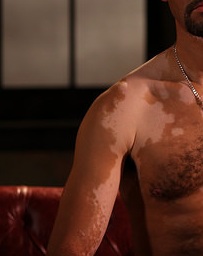80% of the world population is affected by some skin related problems.
You can easily observe the presence of different skin problems like eczema, psoriasis, rosacea, hives, dermatitis, vitiligo, etc. This write-up will deal about using turmeric for vitiligo.
Today we are going to discuss vitiligo. Also termed as “Leukoderma,” it is not a very common skin condition, and only about 10 percent of people suffer from vitiligo. Children have the higher chances of getting affected with vitiligo. The absence of pigments can cause colorless or white patches on the skin.
Generally, body parts like face, knees, elbows, hands, wrists, feet and genitals are more affected with vitiligo.
There are so many assumptions regarding the exact causes of vitiligo, and hence, there is no proved treatment present which can help you to get rid of vitiligo properly. Some natural and home remedies are more than adequate in almost all types of skin related problems, including vitiligo.
Turmeric is an excellent natural remedy for skin, and this is the center of our discussion. We are going to have a fruitful debate over benefits of turmeric to treat vitiligo. Let’s start with the causes of Vitiligo.
What Causes of Vitiligo?

As we have already discussed exact causes of vitiligo is still not clear, it is assumed as an autoimmune disease after very long and detailed studies and researches. Diseases like vitiligo happen when your immune system (known for its defensive actions) mistakenly start attacking the cells of your own body.
In case of vitiligo, the immune system may destroy the melanocytes of the skin. Vitiligo can be genetic as well. People having affected with it may pass the disease to the next generation. If we believe the facts presented by some well-known scientists, melanocytes can also destroy themselves in some abnormal conditions. Other infrequent causes of vitiligo are sunburn and emotional distress.
Is Turmeric Good for Vitiligo?
Why are we talking about the effects of turmeric in case of vitiligo? Why is turmeric believed to be a rare solution of vitiligo? Let’s find out.
Antioxidant property:
Oxidative stress in case of vitiligo can cause the increase in production of hydrogen peroxide and reactive oxygen species in the skin. Which can lead to the inhibition of melanin production going through different stages like DNA damage and cell death? Curcumin present in turmeric can halt this progress by its incredible antioxidant properties.
Anti-inflammatory properties:
Some prominent signs (especially transient phase) of inflammation is also seen in case of vitiligo. Turmeric is also very useful to inhibit the inflammatory effects in case of vitiligo.
Skin regeneration property:
Turmeric, thanks to the curcumin (most crucial active ingredient) helps in repairing skin due to its antioxidant and anti-inflammatory properties. By this repairing properties, it can be more than just effective to improve the skin damaged due to vitiligo.
There are plenty of more skin related benefits of turmeric which suggest that prolonged and proper use of turmeric can be helpful to reduce the effects caused due to vitiligo.
Also read: Is Aloe Vera Good for Vitiligo?
How to Use Turmeric for Vitiligo?
We have already learned, how effective turmeric can be in case of vitiligo. You can increase its effectiveness by using it smartly with other skin-friendly ingredients. Let’s have a look at some of the handy recipes made with turmeric to get rid of vitiligo.
#1. Turmeric with Radish Seeds and Vinegar
Due to the presence of significant amount of vitamin B, vitamin C, different minerals as antioxidants, radish seeds can be very healthy to improve the health of the skin by reducing oxidative stress. Vinegar maintains the pH level of the skin and can promote healing.
- Soak approx. 40 gram of finely pounded radish seeds in a little amount of water.
- Leave it for overnight.
- Add 2 tbsp. Turmeric powder to it.
- Mix all these ingredients to make a fine paste.
- Apply the paste continuously for better results.
#2. Turmeric with Basil Leaves and Lime Juice
Basil or Tulsi is perfect for skin. In addition to purifying blood from toxins, it can repair the skin and can give skin its natural color and tonicity. Lemon juice is also beneficial in case of so many skin problems. It can exfoliate skin and can also help the skin cells to be healthy and active.
- Take some extracts of basil leaves and add some drops of lime juice and 1 tbsp. turmeric to it.
- Apply it thrice in a day for 5-6 months for better results.
#3. Turmeric and Red Clay
Red clay contains a lot of minerals and can soothe the skin to a great extent. Red clay is also very handy for purifying, brightening and strengthening of the skin cells.
- Take 2 tbsp. red clay and add a pinch of turmeric to it.
- Add some water to make a fine paste.
- Apply twice a day on the affected parts for at least 6 months.
#4. Turmeric with Copper Treated Water
You will be amazed after knowing great skin benefits of copper. Drinking water stored in the copper container is beneficial to increase the production of melanin and hence to normalize the skin color.
- Take a glass of copper treated water.
- Add 1 tbsp. turmeric to it and stir well.
- Consume twice a day for 4-5 months and observe the changes.
#5 Turmeric with Mustard Oil
Mustard Oil has excellent anti-inflammatory properties. In addition to it, this ordinary oil is also known for antibacterial and antifungal properties. By halting the inflammation caused due to vitiligo, mustard oil can reduce the effects of leukoderma.
- Soak 500 grams of dry turmeric in eight liters water and leave for 8-10 hours.
- Boil the mixture until only 1/8th part of the original volume is left.
- Add 500 grams of mustard oil and strain it properly.
- Heat the mixture until only mustard oil is left.
- Let it cool down and store in a dry and airtight container.
- Apply the mixture correctly on affected area daily for 6-8 months.
#6 Babchi Seeds and Turmeric for Vitiligo
“Babchi” is the common name of “Psoralea Corylifolia” which is one of the most effective home remedies for vitiligo. This wonderful seed is known as “Kustanashini” in Ayurveda which means “Leprosy Destroyer.” It works wonder in case of leprosy and is also very useful in vitiligo.
- Take a handful of Babchi seeds and make a fine powder by grinding.
- Add an equal amount of turmeric powder and required water to prepare a fine paste.
- Apply to the affected areas correctly.
- Keep applying twice a day until you get the desired results.
#7. Turmeric with Ginkgo Biloba
Ginkgo Biloba is handy to restore the pigmentation. It becomes critical in case of vitiligo because it can inhibit the growth of its progress to different parts of the body.
- Take a handful of Ginkgo Biloba leaves and mash properly.
- Add 2-4 tbsp. turmeric powder and a little amount of water.
- Prepare a fine paste and apply appropriately on the affected parts.
- Keep the process repeating for at least 5 months.
#8 Turmeric with Pomegranate leaves
Punicin acid of pomegranate is known for improving blood circulation. It can enhance the flow of blood to all parts of the body. Proper blood circulation to the cells beneath the vitiligo affected skin can be handy to reduce the effects of vitiligo.
- Take a handful of dried pomegranate leaves and convert into powder.
- Add a little water to make a fine paste.
- Add 2 tbsp. turmeric powder to it.
- Apply regularly on the affected area for 6-7 months.
#9. Turmeric with Neem
Azadirachta Indica or Neem is an excellent remedy for all types of skin related problems. Consuming juice made with neem leaves can be beneficial to treat leukoderma.
- Collect a handful of leaves into a medium-size bowl.
- Add a half glass of water into it.
- Add a tbsp. turmeric, a pinch of black pepper and a pinch of salt.
- Make juice with the help of a mixer.
- Consume a glass of juice daily for better results.
#10. Turmeric with Goosefoot
Goosefoot as a vegetable contains loads of health-related benefits. This wonderful herb is also very useful in vitiligo.
- Take required amount of goosefoot and add 1/2 glass of water to the bowl.
- Mix 1 teaspoon of turmeric, a pinch of salt and a pinch of black pepper.
- Blend all listed ingredients to make juice.
- Drink it regularly to get rid of vitiligo.
#11. Turmeric with Ammi Visnaga
Ammi Visnaga or Khel is a beautiful plant with some very vital attributes which make it very beneficial in case of vitiligo. According to the researchers and dermatologists, it is convenient to reduce the effects of vitiligo in loads of examples.
- Take a handful of Ammi Visnaga leaves and make a fine paste with a grinder.
- Add half tbsp. turmeric to it and apply twice a day.
- Follow the process daily for 6 months for desired results.
#12. Turmeric with Ginger Leaves
Ginger is another very active ingredient in case of most of the skin related conditions. It is full of over 40 antioxidants and can be very handy to increase the production of melanin and hence can reduce the white spots caused due to vitiligo.
- Take a handful of ginger leaves and prepare a fine paste by grinding.
- Add a little amount of turmeric and mix it properly.
- Apply thoroughly on the affected areas daily for 6-8 months.
Important Tips to Reduce Vitiligo
- Consume enough Vitamin B12 and folic acid.
- Make sure you take enough zinc and copper with your diet.
- Vegetables rich in Vitamin C like capsicum are must for people suffering from vitiligo.
- Keep your body hydrated by taking enough water and other liquids.
- Manage your stress and add exercise and physical workout in your daily life.
If you ever used turmeric to get rid of vitiligo, then share your experience in comments.




